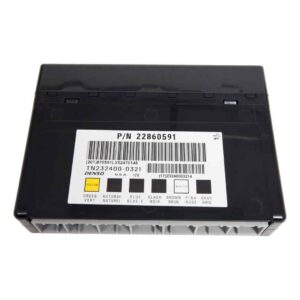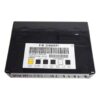Tired of Chasing Electrical Gremlins in Your GM Vehicle?
As a technician with over two decades of diagnostic experience, I’ve seen firsthand how a failing Body Control Module (BCM) can turn a reliable vehicle into a source of constant frustration. Are your power windows acting up? Do your interior lights have a mind of their own? Is the security light flashing, preventing your car from starting? These aren’t random quirks; they’re classic signs that the central command center for your vehicle’s electronics—the BCM—is failing. This isn’t just an annoyance; it can affect vehicle security and drivability.
Instead of paying dealership prices and waiting for appointments, you can solve the problem yourself. We offer a reliable, fully tested GM Body Control Module that arrives at your door programmed and ready for installation. Simply provide your vehicle’s VIN at checkout, and our experts will flash the module with the latest GM software specific to your car or truck. This eliminates the need for expensive scan tools or a trip to the dealer for programming, getting you back on the road faster.
Case Study: A Tricky Diagnosis
A customer brought in their 2008 Chevy Impala last month with a bizarre set of symptoms. The radio would turn on and off randomly, the power locks worked intermittently, and the anti-theft light was on, causing a no-start condition. They had already replaced the battery and checked fuses with no luck. A quick scan revealed multiple U-codes (U0140, U0155), indicating a loss of communication with the BCM. After confirming power and ground to the module were good, we identified an internal failure in the original BCM. Swapping in a pre-programmed module like this one resolved all issues in under an hour. It’s a common failure point I’ve seen on hundreds of these GM platforms.
Is Your Vehicle Showing These Symptoms?
A faulty BCM can cause a wide range of issues that seem unrelated. Here are the most common signs that your GM Body Control Module may need replacement:
- ✔ Erratic or non-functional power windows, door locks, and mirrors.
- ✔ Interior or exterior lights staying on or not working at all.
- ✔ The security or anti-theft system light is illuminated, often causing a no-start condition.
- ✔ Horn honking unexpectedly or not working when pressed.
- ✔ Wipers activating on their own or not responding to the switch.
- ✔ Diagnostic Trouble Codes (DTCs) related to communication errors, such as U0140, U0100, or other U-series codes.
A Straightforward Guide to Your BCM Installation
Installing your new BCM is manageable for a DIYer with basic tools. The location varies by model (see fitment list), but it’s typically under the dash. Follow these general steps for a successful replacement.
- Safety First: Disconnect the negative terminal from your vehicle’s battery to prevent any electrical shorts.
- Locate the BCM: Find your old BCM. Common locations are behind the driver’s or passenger’s side of the dashboard, or near the steering column.
- Disconnect and Remove: Carefully unplug all electrical connectors from the module. Note their orientation. Then, unbolt or unclip the module from its mounting bracket.
- Install the New Module: Mount your new, pre-programmed BCM in the same location and securely reconnect all the electrical harnesses.
- Reconnect Battery: Reattach the negative battery terminal.
- Perform Relearn Procedures: This is a critical step. You will need a capable diagnostic tool to perform the ‘Setup SDM Primary Key in BCM’ procedure to clear the airbag light. Some vehicles may also require a Brake Pedal Position Sensor recalibration. Failure to do so can leave warning lights on and systems inoperative.
- Test All Functions: Start the vehicle and test all body functions: lights, wipers, locks, windows, radio, etc., to confirm the repair was successful.
Verified Vehicle Compatibility
This module is a direct replacement for numerous part numbers and fits a wide array of GM vehicles. Please confirm your vehicle is on this list. Note the specific location for your model.
Fits Models Including:
• Acadia 07-12 (LH dash)
• Avalanche 1500 10 (under steering column)
• Caprice 11-13
• Captiva Sport 12 (center dash)
• CTS 08-13 (LH/RH dash)
• DTS 06-11 (RH center dash)
• Enclave 08-12 (LH dash)
• Equinox 07-09 (center dash)
• Escalade/ESV/EXT 10 (under steering column)
• Express/Savana Vans 08-12 (center dash)
• G8 08-09 (center dash)
• Hummer H2 08-09 (LH firewall)
• Impala 06-13 (LH dash)
• Lucerne 06-11 (right side dash)
• Monte Carlo 06-07 (LH steering column)
• Outlook 07-10 (center dash)
• SRX 07-09 (LH dash)
• STS 10 (center dash)
• Suburban/Tahoe/Yukon/Yukon XL 10 (under steering column)
• Torrent 07-09 (center dash)
• Traverse 09-12 (LH dash)
• Vue 08-10 (center dash)
*Please verify your specific model and options as some IDs may differ.
Frequently Asked Questions
Do I need to do any programming myself?
No. We handle all the programming before shipping. We use your vehicle’s VIN to load the correct software and updates, so it’s ready for installation right out of the box.
Where do I provide my VIN?
After you complete your purchase, you will need to send us your 17-digit Vehicle Identification Number (VIN). We cannot program and ship your module without it.
Will this fix my ‘Service Airbag’ light?
After installation, the airbag light will be on. You MUST perform the ‘Setup SDM Primary Key in BCM’ procedure with a professional-grade scan tool to synchronize the new BCM with the airbag system and turn off the light.
What tools are required for the installation?
Basic hand tools like a socket set and screwdrivers are usually sufficient for removal and installation. However, you will need a capable bi-directional scan tool for the post-installation relearn procedures (airbag and possibly brake pedal sensor).
Is this a brand new part?
This is a high-quality, tested, and guaranteed functional part that has been programmed with the latest software for your vehicle, offering a reliable and cost-effective solution.
What if I have issues after installation?
First, double-check that all connectors are fully seated and that the required relearn procedures have been completed successfully. If problems persist, our expert support team is here to help you diagnose the issue.



